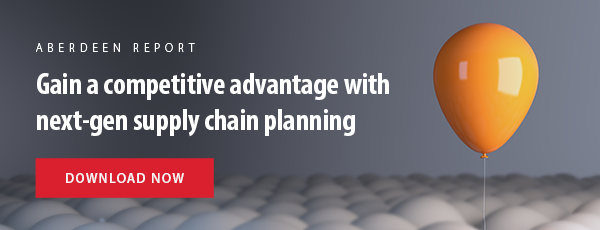
Editor's note: You can find part two of this series here.
Keeping up with today’s technological advancements feels like a full-time job. The same goes for your supply chain planning software. It’s not easy.
ERP vendors like SAP and Oracle have a broad list of modules and applications for supply chain planning. On top of that, there are dozens of best-of-breed vendors that offer up point solutions, for example, demand planning or inventory optimizations tools. Do you settle on specific functionality and get everything from one vendor or introduce another vendor into your stack but get a better tool? The question was sparked by the recent Aberdeen research paper Gain a Competitive Advantage with Next-Gen Supply Chain Planning and has been raging since at least the 1980s. But what’s the answer? It’s not an easy question to answer if you’re looking to up your supply chain game. We’ll get into why that is.
It’s 2020 and there are new realities for supply chain
If you remember the ‘80s, in hindsight it seems like it was a simpler time ‒ big hair, spandex and Journey’s killer song “Don’t Stop Believing” blasting out of cassette players. Supply chain started at the front door and ended at the back door.
But it’s a new time that requires new thinking.
Today supply chain practitioners must keep their global supply chains moving while at the same time researching new digital capabilities that could transform their processes. For the most part, this has been referred to as the bimodal supply chain.
Back in 2016, the main theme of the Gartner Supply Chain Conference was the bimodal supply chain. David Willis, Chief of Research at Gartner stated that successful supply chain leaders will succeed in orchestrating the use of digital technology across their entire business. This is where the bimodal supply chain comes in. Mr. Willis suggested leaders “should divest outdated capabilities in order to invest in a new approach to supply chain.”
Why the new approach to supply chain? Three big reasons include:
- Customer expectations are rising. From a retail perspective, consumers have come to expect next day or even same day delivery (thanks, Amazon!).
- Stuff happens and it’s intense. Supply chain disruptions now seem to be the norm. Weather, political and regulatory disruptions are happening at a much higher frequency and intensity. We’ve seen pandemics in the past like SARS and Ebola, now the world and the connected supply chains are dealing with the coronavirus and its impact.
- Competition is stiff. The supply chain can be a competitive advantage, but only if you can manage the first two points better than everyone else.
To handle today’s challenges and improve the supply chain, companies must focus on increasing responsiveness while still being efficient and profitable. This is more than just building strategic inventory buffers for rainy days. Leaders are taking advantage of emerging technologies to dramatically improve responsiveness. Unlike the ‘80s, visibility, information and insights are the new inventory that helps organizations be agile, efficient and effective.
The question for IT and business leaders is, “Who do I go to for these emerging supply chain planning technologies?”
Buyers in some cases are given a directive to purchase from the current ERP vendor. But placing restrictions on your bimodal approach will certainly close doors on new improvement opportunities.
Getting to the top of the supply chain podium needs a focus on key requirements, not who you’ve done business with in the past. Even so, there must be good reason to look to your ERP vendor if this directive is still being enforced. Here’s a guess at a few reasons.
Reason 1: The perception is that data integration is easier with a single vendor
What do Bigfoot, the Loch Ness monster and easy integration with a single vendor all have in common? They’re all myths.
The biggest myth of the best-of-breed versus single ERP vendor debate is that the integration will be smoother and easier if it’s from a single vendor. On the flip side, solutions from outside vendors will not work well with other software in the environment, and the integration will run over time and budget.
The reality is that today’s supply chain is global. Not to take away from the advantages of a company achieving a single ERP environment, but it’s unlikely that all your suppliers, customers, distributors, sub-contractors and logistics providers will all be on a single instance.
Whether you’re on one instance or not, you’ll have to get good at integrating data from multiple sources. You may have multiple sites on SAP but one or two sites on Oracle or a supplier on a legacy system. ERP vendors as well as best-of-breed vendors need to excel at bringing data together from multiple sources.
Let’s not forget that many of the modules ERP vendors offer up were either acquired or require a dedicated server. Even though the modules are all branded by the same company, they still need an integration effort to talk to each other. This is also the same for any best-of-breed offering up a stack of modules. It’s a tie game when it comes to data.
It was easy to find Lora Cecere’s take on bringing supply chain planning data together into a single instance of ERP. Here’s one of my favorites that she penned in a blog post titled, “Imagining Supply Chain 2030.” Lora observes, “There is a shift from ERP-centric architectures to the use of ERP as only a system of record for financial transactions and the building of analytics architectures that allows data to stream, pool and flow to drive insights.”
Mr. Willis also made similar observations at the Gartner conference that were summed up in the article "Innovate Under Every Condition: The Bimodal Supply Chain": “While it has become the flavor of the day, big data is not the answer. Shift the thinking from big data to big answers.”
Part of the integration myth is that for best-of-breed it will be difficult to share data across different systems. People are getting good at this, and it’s just not best-of-breed vendors that will need to excel at bringing data together from multiple sources and owners. Anyone looking to plan and manage a supply chain will need to think “big answers” rather than big data.
Big answers rather than big data deserves some reflection so we’ll stop part one of this post here. That doesn’t mean the other two reasons we continue to have the single ERP vendor versus the best-of-breed debate aren’t as important.
Tune into the part two in March to find out what those reasons are. In the meantime, checkout the Aberdeen research paper, Gain a Competitive Advantage with Next-Gen Supply Chain Planning.






